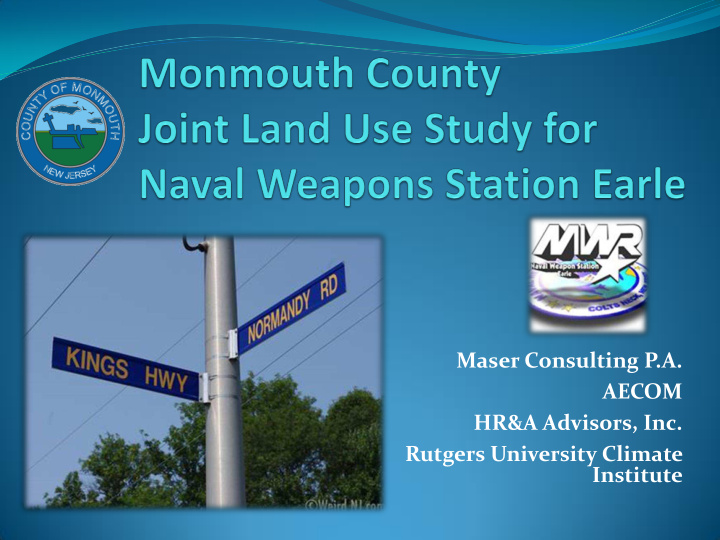



Maser Consulting P.A. AECOM HR&A Advisors, Inc. Rutgers University Climate Institute
Maser Consulting, P.A. Gerald (Jay) DeFelicis, Project Manager Debbie Alaimo Lawlor Regional & Resiliency Planning Public Engagement Document Coordination/Preparation AECOM HR&A Advisors Inc. Rutgers University Richard Dorrier Jee Mee Kim Sarah Bassett Matt Campo Economic Development Military Liaison Planning Climatology Adaptation, Planning Resiliency Planning JLUS Experience Mapping ORGANIZATION CHART Monmouth County Joint Land Use Study for Naval Weapons Station Earle 2
Overview of Maser Team Approach Define the Scope with the Project Partners Establish Planning Team and Technical Working Groups Interview Key Stakeholders Engage the Public – Community Outreach Program Collect, Inventory and Map Project Data Adaptation Analysis Develop Resolution Strategies Recommend Specific Short and Long Term Actions 3
4
Sea Level Rise Assumptions for Naval Weapons Station Earle Joint Land Use Study The sea level rise (SLR) assumptions that the Naval Weapons Station Earle Joint Land Use Study (JLUS) Project Team will use when performing the study are based on the October 2016, the New Jersey Climate Adaptation Alliance (NJCAA) published consensus findings for New Jersey SLR based on the probabilistic approach of Kopp et al. (2014). The JLUS project team reviewed the information presented in Hall et al. (2016), which is informed by the work of Kopp et al. (2014), against the outcomes of the Science and Technical Advisory Panel convened by the NJCAA. The initial review suggests that global sea level rise projections and methods for local adjustments (e.g. vertical land movement (VLM), etc.) are comparable with NJCAA methods and assumptions. While the JLUS project team has not yet reviewed the scenario database for specific projections associated with Naval Weapons Station Earle, the project team does not anticipate deviating from federal guidance to assess local SLR. New Jersey Climate Adaptation Alliance Science and Technical Advisory Panel Overview The information below is excerpted from October 2016 New Jersey Climate Adaptation Alliance publications summary purposes (Kaplan, Campo, Auermuller, & Herb, 2016; R. Kopp et al., 2016). Central Estimate ‘Likely’ Range 1-in-20 Chance 1-in-200 Chance 1-in-1000 Chance 50% probability SLR meets 67% probability SLR is 5% probability SLR meets 0.5% probability SLR meets 0.1% probability SLR meets or Year or exceeds… between… or exceeds… or exceeds… exceeds… 2030 0.8 ft 0.6 – 1.0 ft 1.1 ft 1.3 ft 1.5 ft 2050 1.4 ft 1.0 – 1.8 ft 2.0 ft 2.4 ft 2.8 ft 2100 2.3 ft 1.7 – 3.1 ft 3.8 ft 5.9 ft 8.3 ft Low emissions 2100 3.4 ft 2.4 – 4.5 ft 5.3 ft 7.2 ft 10 ft High emissions 5
Based on the Science and Technical Advisory Panel (STAP) It is likely that coastal areas of New Jersey will experience sea-level rise between 1.0 and 1.8 feet prior to 2050, regardless of future greenhouse gas emissions. Under a worst-case scenario, these communities could see as much as 2.8 feet of sea-level rise by 2050 (See Table 1). Sea-level rise after 2050 increasingly depend upon the evolution of future global greenhouse gas emissions Under the high-emissions scenario , it is likely that coastal areas of New Jersey will experience between 2.4 and 4.5 feet of sea- level rise by 2100. Under the low-emissions scenario , it is likely that coastal areas of New Jersey will experience between 1.7 and 3.1 feet of sea-level rise by 2100. A worst case (1-in-1000 chance) of sea-level rise of 10 feet of sea-level rise in coastal areas of New Jersey is physically possible (See Table 1). Across scenarios, the likely range of sea-level rise in 2100 spans from 1.7 feet to 4.5 feet. However, regardless of scenario, there is at least a 1-in-20 chance of sea-level rise exceeding 1.7 feet before 2050 (See Table 1). 6
Joint Base McGuire Dix Lakehurst EAP Major Issues Urban development Aircraft and ordnance operations noise Environmental issues Airspace issues Utility service sharing Major Recommendations Zoning changes Conservation easements Military representation on planning boards Flight operations monitoring Formalized method to address complaints Real estate disclosures Coordination with Pinelands Commission Regional Partnership program
100 Resilient Cities: Norfolk, VA • Assisted Norfolk’s Chief Resilience Officer complete a comprehensive analysis of the City’s current context; conduct a financial and development analysis for a coastal area of the city; and support the development of the City’s resilience strategy. • Developed a comprehensive resilience strategy that included high-priority, implementable initiatives to build physical, economic, and social resilience. 8
9
Climatology Adaptation Planning & Mapping 10
11
Recommend
More recommend